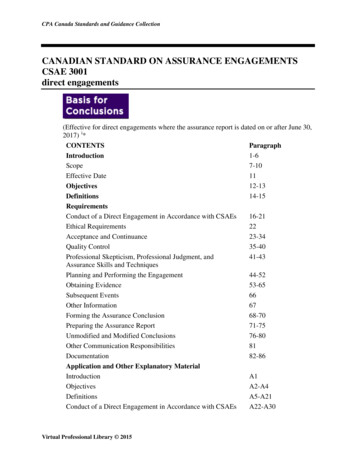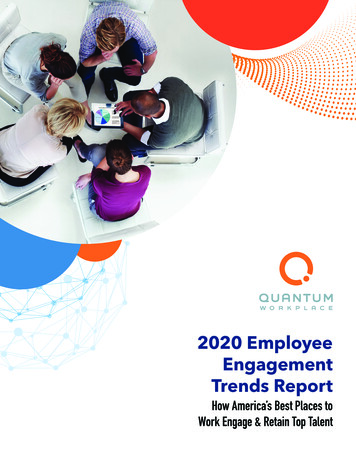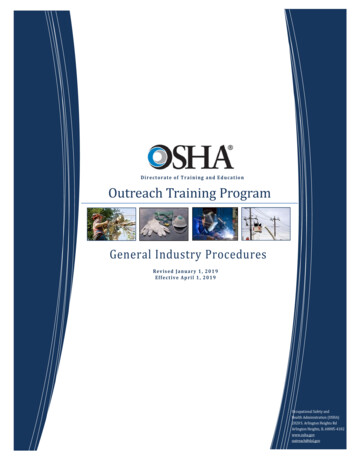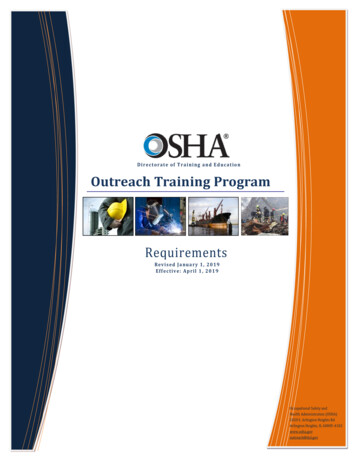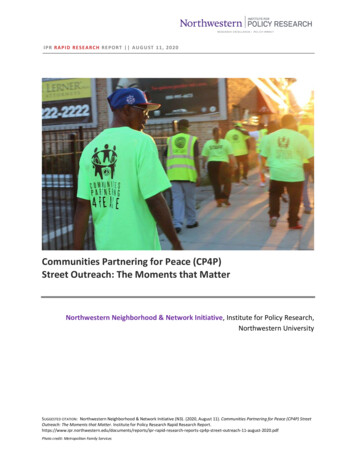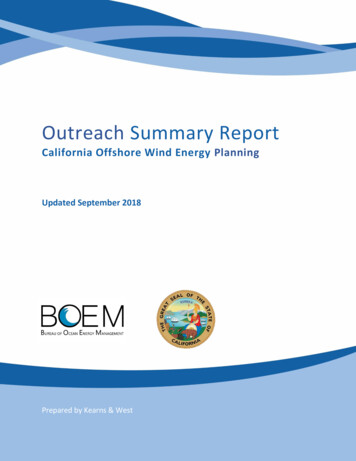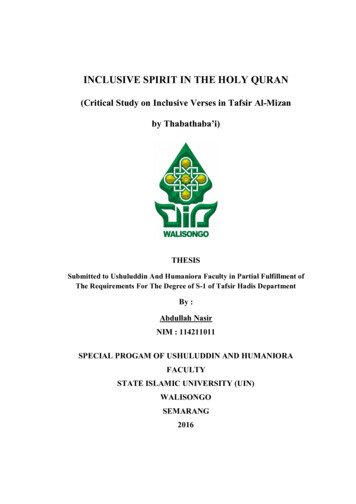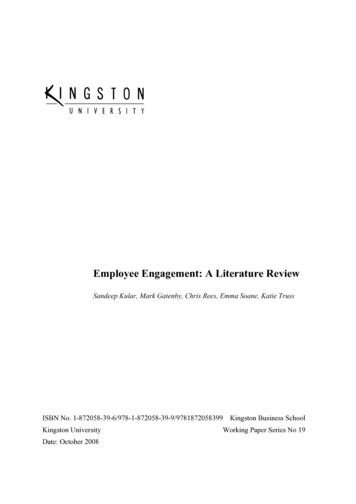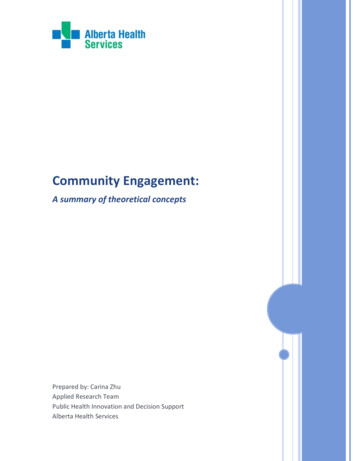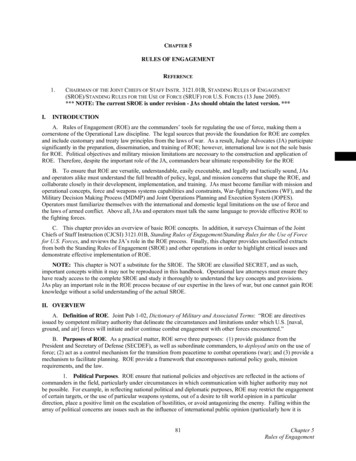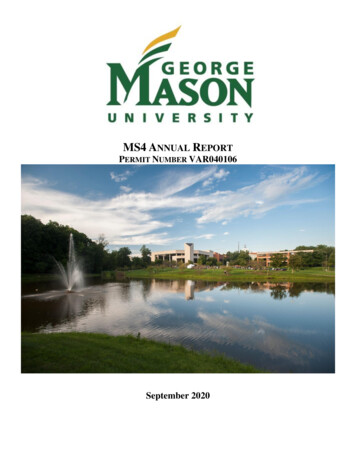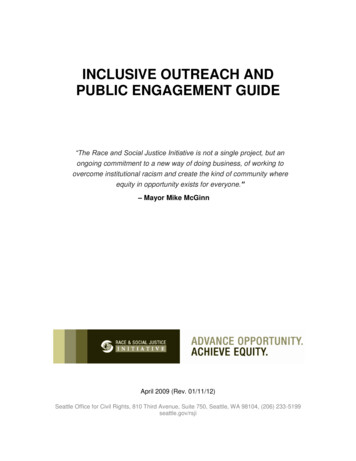
Transcription
INCLUSIVE OUTREACH ANDPUBLIC ENGAGEMENT GUIDE“The Race and Social Justice Initiative is not a single project, but anongoing commitment to a new way of doing business, of working toovercome institutional racism and create the kind of community whereequity in opportunity exists for everyone.”– Mayor Mike McGinnApril 2009 (Rev. 01/11/12)Seattle Office for Civil Rights, 810 Third Avenue, Suite 750, Seattle, WA 98104, (206) 233-5199seattle.gov/rsji
2
CONTENTSThe Inclusive Outreach and Public Engagement Guide is intended to be apractical guide and resource for all City staff. It is also the basis for Citywidetraining on Inclusive Public Engagement. This Guide contains the following:1. Overview -- covers the Race and Social Justice Implications of PublicEngagement.2. Six Essential Strategies for Inclusive Engagement – covers culturalcompetency, and six essential strategies for inclusive public engagement(content provided by Reach Out).3. Quick Guide – a quick look at key elements of effective and inclusivepublic engagement.4. Inclusive Public Engagement Plan Worksheet – worksheet to use indeveloping an inclusive public involvement plan.5. Public Engagement Matrix – covers the five types of engagement andthe tools and activities for achieving them.6. Evaluation Template – a sample outline for evaluating a publicinvolvement process7. Glossary – definitions of key terms and tools and techniques.8. Attachments – Executive Order 05-08 on Inclusive Outreach and PublicEngagement; City’s Inclusive Public Engagement Policy; Outreach andPublic Engagement Liaisons; Translation and Interpretation Policy3
1. OVERVIEWInclusive Outreach and Public EngagementIn 2005, Mayor Nickels established the Race and Social Justice Initiative (RSJI).The mission of RSJI is to end institutionalized racism in City government andpromote multiculturalism and full participation by all residents.To this end, in 2008 Mayor Nickels released Executive Order 05-08 on InclusiveOutreach and Public Engagement that commits all City departments todeveloping and implementing outreach and public engagement processesinclusive of people of diverse races, cultures, gender identities, sexualorientations and socio-economic status. This policy is designed to increaseaccess to information, resources and civic processes by people of color andimmigrant and refugee communities through the implementation of racially andculturally inclusive outreach and public engagement processes. The InclusiveOutreach and Public Engagement Execution Order:A) Acknowledges the barriers that people of color and immigrant and refugeecommunities experience in accessing City government or participating inpublic process.B) Recognizes diversity as both a strength and opportunity.C) Affirms that a healthy democracy requires outreach and publicengagement that takes into account our communities’ racial, cultural, andsocio-economic complexity.Inclusive public engagement is about building strong and sustainablerelationships and partnerships. One of the key components of making our publicengagement processes responsive, inclusive and culturally appropriate isbuilding the capacity of City staff to understand the implications of race, culture,and socio-economic status on public process. This guide is designed to provideCity staff with the tools to:1. Create effective public processes and forums with opportunities forcommunities of color to fully participate.2. Identify the impacts of institutionalized racism and cultural complexity onpublic process.3. Identify and use instruments that help select racially and culturallyappropriate public processes.4. Identify strategies to generate increased interest and involvement in theentire spectrum of government processes and services.5. Identify and use culturally appropriate stakeholder and data analysis toolsthat recognize and utilize communities’ cultural assets and knowledge.4
2. INCLUSIVE ENGAGEMENTTHREE GUIDING PRINCIPLESEnhance Relationships & Engagement:There is a greater likelihood of engagement from underserved communities whenorganizations take steps to enhance their relationships with those populations. Creatingtrusting relation-ships, increasing accessibility to facilities and services, and providingdiverse opportunities to be-come involved, are key actions that reflect on organizationalattitudes and values about developing equitable and sustainable engagement.Enrich Knowledge Gathering:Strengthening connections with communities through knowledge gathering allows thoseconstituents to play a key role in determining relevance and appropriateness oforganizational programming. We must look beyond surveys as a means of gatheringcrucial data and feedback to-wards more personalized modes and means of thisimportant task. In essence, exchanging information, rather than collecting it, provides anincentive for engaging in conversations and collaborations, as well as a greater sense ofownership in the outcome.Embrace Organizational Change:In order for community engagement to flourish, organizations (and individuals thatrepresent those organizations) must be open to organizational changes that areresponsive to community insight and allow for shared power between communities andthe organizations that serve them. The process and results of increased communityengagement must go beyond activities to involve more community members, but ratherbecome a prominent organizational value that drives everyday decision-makingprocesses.Goals of Public EngagementEmpower communities to make decisions for themselvesRelease the capacity and potential of communitiesChange relationships between service providers and communitiesRacially and Culturally Appropriate Public Engagement Delivers ResultsBetter quality and responsive services and better outcomesReduction of inequalities and greater ownershipA better understanding of why and how services need to change and developChallenges of Implementing Racially and Culturally Appropriate PublicEngagementRelationship changes are time consumingDifficult to measure and undermine original power structureConflict is inevitable*Reference: Emmel and Conn (2004), Hudson, (1999), London Department of Health, (2002)5
CULTURAL COMPETENCY CONTINUUMWhat is the Continuum?The cultural competency continuum represents a spectrum into which we can placebehaviors, attitudes, policies, and practices. This is intended to be a dynamic tool, sincethere is always room for growth and development in individuals, organizations, andinstitutionalized policies and practices.Why do we use the Ladder?In assessing our capacity for cultural responsiveness, it is useful to have a tool that isfocused on core ways to interpret the wide range of behaviors and attitudes that areexpressed in the policies and practices of an organization. This tool provides the meansto assess cultural relevance in current operational standards, as well as the frameworkto guide progression towards fully integrated institutionalization.How can we use the Ladder to impact our work?Issues stemming from race and other cultural matters are quite broad and varied.Individuals and organizations will find that they are quite knowledgeable and proficient insome aspects of cultural consideration, and yet, may neglect asking crucial questions inanother area. For instance, we may be acutely aware of making focus group (or other)accommodations for the hearing impaired community, but may not have a cache ofoptions to make public health programs accessible to the P'urhépechan community (anindigenous Central American group that relies heavily on oral communication - Spanishis not their native language). When we begin to consider our approach to engagementwith this community, we can gauge why mainstream strategies will have a lowereffectiveness and work from a more culturally responsive foundation. Ultimately, themore our work stems from relevant aspects of racial and cultural identity, the greater ourchances for effective outcomes and increased engagement from that community.Please ReadIt is important to note that the examples in Blindness and Pre-Competence can be usedas pieces in a more comprehensive approach to public engagement. It is intended thatyou use this ladder to consider alternate or additional strategies that reflect a culturallyaware, multi-faceted approach to-wards more effective engagement.6
CULTURAL COMPETENCE CONTINUUMCULTURALSTAGEDESTRUCTIVENESSWhere people activelybelittle other culturesASSUMPTIONSForced assimilationRights and privilegesfor only dominantgroup“We deserve this”“This is the ONLY and RIGHTway”POWER DYNAMICSAccess and power areonly given to a privilegegroup other membersare purposely excludedCULTURALINCAPACITYCULTURALBLINDNESSWhere people showno interest in orappreciation ofother culturesWhere people treat allcultures as if theywere the sameLowerexpectationsMaintainstereo-types“People choose not tobe a part of theprocess” “This is justthe way we do it here”Education is stilldesigned forprivilege groupand noaccommodation ismade t try toinclude othergroupsEXAMPLESExclusive PublicMeetingsTraditional“Town Hall”model“English cesignored “treateveryone here people haveacceptance andrespect for difference,and continue selfassessmentSeeksadvice/consultationIdentifies whatthey are NOTcapable of doing“I don’t see color, we areall just the same”“Let’s just hire anexpert”“just give me a checklist”“Teach Me Phase”Noacknowledgementof powerdifferences(institutional racism,classism, immigrantor refugeeexperience, etc.)power is still held bydominant groupPower differencesare acknowledged,with someunderstanding butreliance on ULTURALCOMPETENCEWhere peopleunconsciously holdculture in highesteem, and use thisto guide theirlives/workRecognizesindividual andculturaldifferenceDevelops newapproaches“Let’s work together totruly empowercommunities”Target communityhas a role (realpower) ineducation designand application(“experts”)Consult with orhire (one)member of anethnic communitySpecial (one time)ProgramsNative AmericanArt andStorytelling(targetpopulationdesigns process,holds realpower)TrustedAdvocate Model(power sharing)Adapted from: Cross. T.L., Bazron, B.J., Dennis, K.W., & Isaacs, M.R. (1989). Towards a culturally competent system of care volume 1:A monograph on effectiveservices for minority children who are severely emotionally disturbed. Washington D.C. CASSP Technical Assistance Center, Georgetown University Child DevelopmentCenter.Copyright 2004-2009 REACH OUT * www.reachoutfornewfutures.org All Rights Reserved.Reproduced with Permission for the The City of Seattle Office of Civil Rights Until December 201
SIX ESSENTIAL STRATEGIES FOR INCLUSIVE ENGAGEMENTEffective community engagement takes careful planning and acknowledgement thateach population that we work with is a unique opportunity to broaden ourunderstanding of what makes a community.To help you think about ways to use each strategy, we have provided criticalquestions to consider, as well as successful examples to illustrate creative ways toconnect with your target group.1. Build personal relationships with target populationQ1 Are there key individuals or constituents you already have or should bebuilding a relationship with?Q2Are there venues for you to attend or explore to find out who are naturalcommunity leaders?· Informal/Community driven gatherings that are appropriate to attend· Connect with the individuals in this community/population2. Create a welcoming atmosphereQ1Does your process reflect, honor, and welcome the community?Q2Do the venues you choose invite participation and engagement?· Hire staff or consultants from the community or that reflect the target population· Choose gathering places that are comfortable and that are conducive to the interactions thatyou want to have3. Increase accessibilityQ1Are there issues/barriers (language, location, time, transportation, childcare, food,incentives, appeal, power dynamics, etc.) that should be considered throughoutthe whole process?Q2Are there ways to increase the level of input a community has in a process?· Selecting the most appropriate and effective communication method to promote engagementopportunities· Decrease barriers to attendance or effective communication at events
4. Develop alternative methods for engagementQ1Do you have non-traditional methods of outreach to get people involved?Q2Do you offer multiple ways for contributing input and feedback?· Provide opportunities for social interaction and relationship building· Provide opportunities for community members to give feedback in photographic, voicerecorded, or video formats5. Maintain a presence within the communityQ1Are there community driven events that you can participate in and thatpeople will already be gathering for?Q2Do community members see you out, regularly, in the community?· Attend community driven events and activities (think non-traditional)· Establish places in the community that people can have sustained, informal interactions withyou6. Partner with diverse organizations and agenciesQ1Are there organizations that currently have relationships with your targetpopulations that you can connect with (remember to consider powerdynamics)?Q2Have any agencies or organizations successfully implemented similarprograms or initiatives (perhaps on a smaller scale or in another community)that you can solicit advice from?· Connect with organizations who are already culturally tied to the target community or arecurrently providing services to your target population· Create a network of services that eliminate gaps or reduce redundancies for the targetpopulation9
3. QUICK GUIDEKEY STEPS TO INCLUSIVE PUBLIC ENGAGEMENTWhat To DoDefine Scope of WorkHow To Do itIdentify the decisions to be made and determinewhere and how the public can influence decisions –use this to define the public’s roles.Identify racial and ethnic population affected by theprocess or project. Does this project impact racialdisparity? Institutional racism? Multiculturalism?Identify StakeholdersIdentify the stakeholders. Who does this affectdirectly or indirectly, positively or negatively? Who istaking a risk, who has responsibility?Define RolesDefine roles for the public, your department, andother stakeholders.Who else in your department is involved? Howabout other agencies? Other institutions andorganizations in the community? Elected officials?Incorporate Raciallyand CulturallyAppropriateEngagement ActivitiesAssess scope of work for incorporating the sixstrategies for more inclusive engagement.Identify relationships with communities of color,create a welcoming atmosphere at all events, insureaccessibility for all participants, develop alternativeand culturally appropriate methods for engagement,maintain an ongoing presence in the community anddevelop partnerships with organizations or color.Create an InclusivePublic EngagementPlanPrepare a public engagement plan. Include keyactivities, milestones, and products on the projecttimeline.Develop a detailed work plan that includesspecific engagement activities based on anoverall strategy. Identify and make use ofappropriate tools consistent with the defined roles,issues, audience, and resources.10
What To DoStaffing & OrganizationHow To Do itDesignate a lead public involvement staff, keyteam member with project manager.Establish the staff/resource needs for publicinvolvement at the outset – from communicationsstaff, or outside facilitators and consultants. Includepotential translation and interpretation costs.Identify an internal team to use for advice: Set upinitial and regular times to meet with them forupdates and advice.Communications &OutreachCreate a clear identity and message for the projectfrom the outset.Carry out broad outreach, using multiplecommunications tools to reach the diversity ofstakeholders (e.g. mailed and printed information,website and email lists, cable TV and PSA’s)Include targeted outreach to communities of colorand other affected groups that tend not to participate(consultations with leaders; info at communityevents, speakers, etc.)Have a single contact point for the public (e.g. ahotline and/or email address) to provide easy accessto the public to get information and provide input, onthe project.Use the media strategically – press releases,feature stories, op-ed’s, news conferences toannounce initiation of project; key milestones anddecision-points. Focus on community newspapersand programs, including ethnic media.Use public facilities – branch libraries, communitycenters, neighborhood service centers as informationrepositories to provide ongoing information on theproject.Use technology to promote an interactive publicprocess – use your agency/organization’swebsite to provide information and opportunities forfeedback through the life of the project.11
What To DoDecision MakersHow To Do itKeep decision-makers informed – from reviewingthe scope of the public involvement plan to updatesafter events/activities.Prepare and present a final report on the results ofpublic involvement and how it has affected theproject outcome – through periodic briefings.Accessibility &TransparencyMake sure the process is open and accessible toall stakeholders – initial and ongoing outreach,communications, engagement activities andfeedback.Ensure that the public involvement process is“transparent.” Make information accessible –project related information and results from publicinvolvement and how it is being incorporated into theproject process.Regular updates (on the Web posting, throughnewsletters or postcards, etc.) are on important wayto do this.Staff contact and relationships with key stakeholdergroups is also effective in providing transparency.Evaluate the ProcessInclude evaluation of the overall process and ofspecific public activities -- It is critical to learn fromyour experience, replicating what works; changingwhat didn’t work.Use evaluation forms at meetings/activities; onlinefeedback to obtain information from stakeholders(not just the public, but other agency staff,institutions, etc. who are participating in the process).Track and record participation in the process bycommunities of color.Include results of the evaluation in your report todecision-makers.12
4. PLANINCLUSIVE PUBLIC ENGAGEMENT PLANIdentify the need for and purpose of public engagement. Identify theappropriate level of community involvement with staff and through earlyconsultation with key stakeholders. Develop a public involvement plan,including strategies for inclusive engagement.The following three steps are recommended before filling out the rest of theworksheet:Step 1Step 2Step 3DescriptionReview inclusive engagement strategies (see Section 2), and theand the public engagement matrix (see Section 5).Identify appropriate staff to complete the analysis; determinewhether Change Team and/or Core Team assistance would bebeneficial. The Department of Neighborhoods’ District Coordinatorsand the Customer Service Bureau are also key resources for yourpublic engagement planning.Collect data necessary for completion of the Racial Equity ImpactAnalysis (see sidebar for resources).1. What is the scope and goals of the issue/process?Provide description: (Does it build on something existing or is this new? Is itdemographically based? Citywide versus smaller geographic area; non-geographic;affects everyone equally or some groups more than others. What is the finalproduct?)RESOURCES:Department ChangeTeams can assist inthinking throughpotential impacts ofthe proposed projector process.Department ofNeighborhoodsPublic EngagementToolkit.Demographic dataand mapshttp://www.census.gov/Language maps andlists of interpretationand #interptranspolicy„Disparities‟: Asnapshot of Seattleinweb.ci.seattle.us/rsji/docs/RSJ statssheet-final.pdfDoes the proposed project/issue directly or indirectly impact (check allthat apply):Racial disparity (different outcomes for individuals based on race. e.g. aresome services benefiting some communities more than others.)Institutional Racism (policy or program change that impacts communities ofcolor.)Multiculturalism (equal rights and respect for all cultural groups. Creatingthe conditions for understanding, respect and interaction between cultures.)13
RESOURCES:Raise Awareness (Explicitly educates about the importance of historicaland contemporary facts regarding race, racial disparities, and/or culture.)Please describe:Department ofNeighborhoodsPublic EngagementToolkit.Demographic dataand mapshttp://www.census.gov/Who’s affected by the proposed project/policy?General populationRace and ethnic populationSpecific groupsSpecific area(s)Language maps andlists of interpretationand #interptranspolicy„Disparities‟: Asnapshot of Seattleinweb.ci.seattle.us/rsji/docs/RSJ statssheet-final.pdfPlease describe how these groups are affected:3. What is the timeline for completion of this process?Deadline for project completion:Describe Timeline: (Include any legal requirements (e.g. SEPA), politicalcommitments, and staff goals.)14
4. What is the public’s perspective in this process/project? Whatdegree of public influence is possible? (It is important to manageexpectations. Be clear about what you want participants to contribute to the process,what they will gain from taking part, and the extent to which their input can influencedecision-making.)What are the objectives in involving the public in this process/project?To help with policy making:Use it to define the problems, to find solutions, or both.Establish the complexity of an issue.Develop innovative policy options.Test out ideas.Build consensus.Identify and understand the risks.Find the most effective and cost-efficient solutions to problems.To help relations with community:Ensure community feels heard on the policy-making process.Sharing with community the pros and cons of policy options.Building relationships with specific racial/ethnic communities.Strengthening relationships between constituencies.Developing alternative methods for public engagement forracial/ethnic communities.Partnering with community organizations.Maintaining and deepening relationships within a community.Please describe:What are the constraints to public influence?Previous City commitmentsFunding limitations (amount; how it can be used)Legal constraints (laws that constrain scope and/or solutions)Other:Please describe:15
Public Role: (check all that apply)Inform (Educate the public about the rationale for the project ordecision; how it fits with City goals and policies; issues being considered,areas of choice or where public input is needed.)Consult (Gather information and ask for advice from citizens to betterinform the City’s work on the project.)Collaborate (Create a partnership with the public (key stakeholdergroups) to work along with the City in developing and implementing theplanning process or project.)Shared Decision-making (Decision-makers delegate decisionmaking power to stakeholders or give them a formal role in making finaldecisions to be acted upon.)Describe any legally mandated public involvement (e.g. SEPA):5. What type of decisions are to be made in this process?Describe nature of decision: (What is the decision to be made?Who do they affect? Who influences and who makes the decisions?Who puts together the recommendations for making the decision?Who makes the decision?)Who are the Decision-makers? (check all that apply)Mayoral priorityCouncil priorityOther level of government:Appointed officials:Other Decision-makers:16
6. Who are the stakeholders in the process? (Include all who areaffected: client, sponsor, influencers, end users, “bystanders,” media, othersaffected by the process/action. Pay particular attention to identifying those whotypically don’t participate or have a voice, but who are affected like people of color,immigrants, low income households, elderly, youth, etc.)Identify specific stakeholders:General Public:Racial/Ethnic Groups:Community Based Organizations (advocacy groups, non-profitRESOURCES:Lists of communityorganizations bygeographic area canbe found on theDepartment ofNeighborhoodsPublic EngagementToolkit.Department ofNeighborhoodsDistrict Coordinatorsand departmentPublic EngagementLiaisons can also becalled upon foradvice.agencies):Private Sector (business community, development community):Decision makers (Department Director; Mayor; Council; otherlegislative bodies):City Department(s):Other Public Agencies:Other (those directly affected by the outcome):17
8. What are the stakeholders’ interests/concerns? (Consult withcommunity representatives such as the Immigrant and Refugee Advisory Board as“sounding boards” to help address questions. List the interests/concerns for eachstakeholder group.)What changes do they want and what do they want left unchanged?What are their expectations?What resources do they have?How can they benefit from the policy/project?How would they be affected by the risks? (Are they harmed?)What relationships do they have with others?Check In #1: Project Lead check-in with department leadershipand communications staff and other departmental staff foradvice/approval of initial assessment of stakeholders and roles.9. Is there a need for an advisory group or communitypartnership?How will this be accomplished? (Will you use or build on an existing group orto create a new advisory group? What is the purpose of the group? Specifyresources needed.)18
10. What is the basic communications strategy and goals for theproject?What are the key messages that need to be shared about the project?What is the strategy for communicating with the media? (Includestrategies for working with Ethnic media outlets)What are the translation and interpretation needs of the project?11. What public involvement tools/activities are appropriate forthe project?Describe engagement tools/activities: (Refer to the Public EngagementMatrix (section 5) to determine types of appropriate engagement. e.g. survey, publicmeeting, etc.):Do the tools/activities achieve inclusive engagement?(Review the six essential strategies for inclusive public engagement.)Build personal relationships with racial/ethnic community –Activity deepens existing relationships or establishes newrelationships.Develop alternative methods for engagement – Approachprovides multiple ways for contributing input and feedback and directcommunication with racial and ethnic community.19
Partner with diverse organizations and agencies – Activityprovides opportunity to collaborate with organizations of color anddraws upon leadership from communities of color.Maintain a presence within the community – Activity builds uponpresence in community, or establishes ongoing relationship.Increase accessibility – Activity takes into account language andbarriers to participation like location, time, transportation, childcare, andpower dynamics.Create a welcoming atmosphere – Activity reflects the culture ofthe community and is welcoming.RESOURCES:See PublicEngagement Matrixand Glossary forexplanations ofdifferent types ofengagementactivities.Review Section twoof Guide: “SixEssential Strategiesfor InclusiveEngagement.”12. What resources and responsibilities are needed to carry outthe public involvement activities?Staff Responsibilities and Roles (Project manager, public involvementlead, other staff)Community responsibilities and roles (if applicable):Funding needs – communications, public events, consultant services20
13. What is the public involvement schedule?Develop a timeline and month-by-month calendar of tasks and activitiesfor public involvement. Show how these are connected to project timelineand milestones. In developing these schedules, work back from deadlines todetermine whattypes of involvement is possible given timeframe and deadlines for theproject.Key Dates:14. What are the reporting mechanisms? Identify products thatdocument and report on the outcomes of the public involvement.Media/communications pieces (press packet, news release)Progress report(s)Final reportFormal recommendationsBriefings and presentations for decision-making bodies (involvecommunity participants)Describe:Check in #2: Check in with department leadership andcommunications staff on proposed public involvementstrategy/tools, resource needs and responsibilities, andcoordination with other projects.21
5. PUBLIC ENGAGEMENT MATRIXType ofEngagementINFORMGoal of ParticipationEducate the public about therationale for the project or decision;how it fits with City goals andpolicies; issues being considered,areas of choice or where publicinput is needed.Tools/Activities- Fact Sheets- Brochures- WebsitesInclusive EngagementTechniquesTranslation of all keydocuments.Interpretation at events.- Open Houses- Exhibits/displays (inMessage to the Public: To keep public areas)everyone informed.-Newsletters(mailed/online)- Newspaper articlesGather information and ask foradvice from citizens to better informthe City’s work on the project.- Focus groups- Surveys, interviews, andquestionnaires- Public MeetingsCONSULTMessage to the Public: Will keepeveryone informed, listen to andacknowledge concerns and providefeedback on how public inputinfluenced the decision.- Workshops and workingsessions- Deliberative polling- Internet (interactivetechniques)Translation of all keydocuments.Interpretation at events.Indicators/Evaluation
Type ofEngagementCOLLABORATESHAREDDECISIONMAKINGGoal of ParticipationTools/ActivitiesCreate a partnership with the public(key stakeholder groups) to workalong with the City in identifyingproblems, generating solutions,getting reactions to recommendations and proposed direction.- Citizen AdvisoryCommittee/ LiaisonGroups
promote multiculturalism and full participation by all residents. To this end, in 2008 Mayor Nickels released Executive Order 05-08 on Inclusive . Difficult to measure and undermine original power structure Conflict is inevitable *Reference: Emmel and Conn (2004), Hudson, (1999), London Department of Health, (2002) 6 CULTURAL COMPETENCY CONTINUUM
